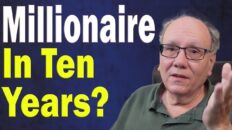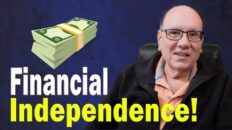I get a lot of questions regarding my style of investing. Is it safe? Can you really get better than 10% returns? Be sure to continue watching as I’ll try to answer these questions and several more today. Eric Thomasson, wow, I get a lot of questions regarding my style of investing.
To start, I would call myself primarily a dividend investor. It’s not a new concept, but I feel that there are a lot of questions and misinformation in general for this style of investing. Before starting, please realize that I’m not a professional investor and I’m stating my own opinions in this video.
So please, please, please, please do your own research and come to good investment decisions that are good for you. Let’s get the first question out of the way. Is it safe? And that’s a very good question.
Let’s start out by saying that all styles of investing will carry risk in one form or another. Sometimes the risk is very high and sometimes very low. You could consider putting your money into your mattress.
And yes, I have seen this done, but the risk that you run is twofold. First, your money isn’t working for you, so it never increases in value. Second, inflation will make every dollar you save worth less over time.
I remember in my teens when about 40 years ago, so that’s a little ways back, I could go to the store with a dollar and buy a soda pop, a bag of chips and a chocolate bar. I know, not good diet. Today, that same purchase would be at least between five and six dollars.
So if I tuck that dollar away in my mattress 40 years ago, it would have a value in today’s money of only about 18 percent. So hopefully you understand that risk exists even if you don’t do anything. The trick here is to eliminate as much risk as possible while still gleaning a good return from our risk taking.
One of the primary ways to mitigate risk is to get as much knowledge about your investments as you can before you begin. This brings me back to dividend investing. Depending on the underlying stocks we’re purchasing, dividend investing can actually be extremely safe.
I believe that the safest thing to invest into are stocks that are considered dividend aristocrats or dividend kings. The first has a dividend that has stayed consistent or increased in value for at least 25 years. The second has the same track record but for 50 years.
Yes, they do exist. This tells me a few facts. First, that the underlying company has staying power.
They’ve consistently made profits for their shareholders and slowly increase these profits over the long term of time. Interestingly enough, these products are that these companies produce are typically products that are timeless and continuously needed. Some good examples of this are Coke, Procter & Gamble, and Johnson & Johnson to just name just a few.
They produce things like soda drinks, soaps, shampoos, toothpaste, bathroom products to name a few. Things that we use every single day. And this brings out the next point regarding these stocks and that this point is really my personal opinion and I could be very wrong here.
These companies are dividend focused companies. Their primary concern is to protect the dividend return for its shareholders. So, they’re less concerned about the price of the stocks and I believe that they’d even forego an expansion to ensure that the dividend is secure.
This also brings up the first argument I hear quite often regarding dividend investing. Well, what am I going to do if the price of the stock or ETF, exchange traded fund, goes down in price? My answer here never changes. But before I give you my answer, if you’re getting value from this video, be sure to subscribe and like it.
I also love to hear your comments, but let’s get back to my answer. I treat stocks that go down like a store putting my favorite goods on sale. I stock up.
This leads me to the second question. Well, aren’t you afraid of the decrease in value of the underlying asset is going to impact you in retirement? And that’s a valid question. That would be a big yes if I depended on selling those assets to guarantee an income into retirement.
But I made a big decision a few years back and that I would try very hard to never get into a position where I’d have to liquidate my assets to retain my monthly retirement earnings. In other words, my returns must solely come from my dividend investing. My intent is I’ll never in my lifetime sell my stocks or ETFs.
The only time I would sell an asset is if it isn’t producing well and can be transferred to another asset that will perform better. Now, it’s important for you to realize that my window of investing is relatively small before I need to start taking from the dividend profits and not just allow them to compound. This leads me to my next point.
I’ve taken more risk in the short term because traditional stocks have relatively low dividend yield. It’s not unusual for these relatively stable stocks have a dividend return of two to six percent. This will slow the compounding action on these resources over time.
So, I personally opted into investing into well-funded ETFs or exchange-traded funds. An ETF is a bundle of stocks within a market sector. That’s a good example of this is SVOL which is a U.S. ETF that invests into stocks in the S&P 500 and has showed a steady increase in value and more importantly is currently returning about a 16% in dividend returns yearly.
Another thing that these funds will use to increase their dividend is to place cover calls on their stock holdings to increase profits as well as they could leverage or borrow a percentage of the capital from the platform that they trade within. This leverage can be anywhere from 20 and I’ve seen as much as 35 percent. So, this will increase the number of stocks that they can work with by the percentage of the leverage that they’re using.
These factors do add more volatility to the fund but they also increase dividends substantially. For example, recently released ETFs are claiming upwards to 15 to 20 percent dividends. The risk here though is that these products are really new and don’t have the same long-term performance proof that dividend aristocrats or kings have.
Ways to mitigate this risk is possibly to invest in the same underlying assets contained in the ETF with another ETF offered by two or three different investment firms. This helps eliminate the risk of a firm that proves itself not being able to manage their assets well. I personally decided to mitigate my stocks to ETFs in the short term.
This way I can sustain an average portfolio return of between 11 and 12 percent. So, I’m not pushing the moon and stars here. The small change will permit me to double my portfolio in as little as six years instead of waiting as much as 14 years with the lower dividend returns from aristocrats and kings.
When I’ve accomplished saving my long-term balance in my portfolio, I’ll then start to mitigate back to these more stable stocks that have lower dividend but they’re a safer bet in the long run. Another reason I love dividend investing is compared to many other types of investing, this is really easy to do. It really doesn’t require a lot of hand-holding to perform well.
I’ll literally check on my accounts probably twice a month. Once when I’m adding funds at the accounts and second when I’m reinvesting any dividends that I’ve earned in the funds that I’m favoring. What does this mean for my situation? Well, right now I’ve got close to $150,000 invested at the moment.
If I continue to contribute around $2,000 monthly and keep an interest rate of a roughly 11.5 percent, when I turn 65 in four years, I should have a balance close to $360,000. Now this still falls short of what I need to have a non-depleting fund, but I’ll explain part two of my plan in just a moment. For that though, another thing I’m looking into is scaling back on my housing and cashing out on a really hot real estate market we’re in right now.
This may permit me to put another $150,000 to $200,000 into our long-term savings. If that happens, our end total in four years jumps to almost $600,000 if we get to at least put another $150,000 into the balance now. Part two is going to be what I think is a good plan for me.
I want to keep my hand in the programming world, so I’d like to be able to work part-time between 60 and 70 making just enough to cover our cost of living. I wouldn’t be contributing any more to the savings, but this would permit the savings to continue to grow. For example, that $360,000 at 65 would grow to over $646,000 at the age of 70.
And if I had the $600,000 at the age of 65, it would grow to out just over a million with no further contributions during either of these situations. Either way, we’re in pretty good shape. So I hope this has made sense to you and if you’ve gotten a few takeaways from it, that’s great.
If you’re younger, you have a tremendous amount of options open to you. But even if you decide to just purchase good dividend aristocrats and kings, you’ll do very well off in 20 to 30 years. Yes, I know it seems like a long time, but that time’s going to pass.
Time here is your superpower and it shouldn’t be understated. If you have a 30-year window and are starting with nothing right now, you decide to invest into the S&P 500. Make it simple, which historically has returns of at least 8% per year.
You intend to invest $500 per month during a 30-year window, let’s say. After 30 years, you would have saved very close to $740,000. If the markets perform better or if you contribute more in time, your nest egg could easily grow to over a million dollars or more.




